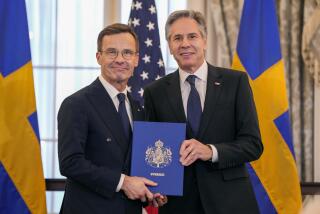Forces Test Sweden’s Historic Neutrality
- Share via
STOCKHOLM — Swedish neutrality has survived intact since the time of Napoleon. But how will it fare without concrete means of support?
Like the cannons of Kalmar castle on Sweden’s east coast, pointing proudly out to sea but taken over by rabbit dens, the foundations of its defense policy are starting to slip.
“Sweden has continually put off reforming its World War II defense structure. Now the issue has become a crisis,” researcher Wilhelm Agrell said.
Swedes have always been led to believe their neutrality rests on two pillars--compulsory military service and self-reliance on the most important weapons. Now both these items are costing too much for a country of 8.5 million people.
“What would happen if we removed the two pillars? Nobody has ever proved that neutrality depends on them,” said Agrell, assistant professor of history at Lund University.
Carl Johan Aberg, chairman of the Parliamentary Defense Committee, said: “We are not thinking about dropping our neutrality. But we need to change what it means in practice.”
Defense officials, politicians and researchers agree that an unchanged defense budget of $5.1 billion means cutting either arms spending or the length of military service from the present 7.5 months, or both.
The military threat to Sweden is perceived not so much as a potential invasion, but that a great power might try to march through on its way to attack Norway or Finland, as happened during World War II, or set up bases here.
Supreme Commander Bengt Gustafsson believes the defense committee’s budget proposals next year will be a turning point.
“The defense industry is in bad shape. Running it down any further could jeopardize our preparedness for war. It is easier to train people in arms than build up a defense industry from scratch,” Gustafsson said.
Sweden cannot expect any immediate benefits from the upheaval within the Warsaw Pact and NATO military alliances.
“While the Soviet military threat on the (European) Continent will be drastically curtailed, the threat to Sweden and Finland will not be affected,” Ingemar Dorfer of the Swedish Defense Research Establishment said in a paper.
Prime Minister Ingvar Carlsson said recently: “We are a neutral country relying on our own strength. We must see a positive development between the two rival military alliances before we draw definite conclusions.”
Sweden’s policy is to design and produce its own military aircraft, ships, tanks and guns to avoid reliance on outside suppliers in time of war.
The country has four out of the world’s 100 largest arms producers and ranks ninth largest in arms exports. However the foreign policy goal of mediating in foreign conflicts prevents unrestricted sales.
“The development costs per plane, per tank are very high because of the small numbers. But non-alliance is becoming less important, and the international price of arms is falling. There could be savings there,” the daily Dagens Nyheter commented.
The first test could come Oct. 1, when the defense procurement agency FMV is due to announce the price it has negotiated with a Swedish consortium for the second batch of 110 Jas Gripen warplanes.
Sweden has already ordered 30 of the lightweight aircraft, which rely on computers for stability and can be used for interception, ground attack or reconnaissance.
The project, delayed by the crash of the first Jas Gripen prototype, is running about $1.3 billion beyond its initial budget of about $8.45 billion, Dagens Nyheter reported.
The plane’s second prototype has now completed two short test flights. “I hope the project survives. But the darned plane has still to prove it can fly,” Dorfer said.
Sweden must also decide next year whether to proceed with a new battle tank designed by the Bofors company. The alternative would be to buy an off-the-shelf M1 from General Dynamics Corp. or the Leopard II from West Germany’s Kraus-Maffei.
More to Read
Sign up for Essential California
The most important California stories and recommendations in your inbox every morning.
You may occasionally receive promotional content from the Los Angeles Times.













